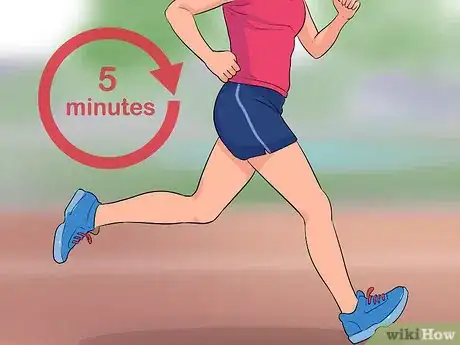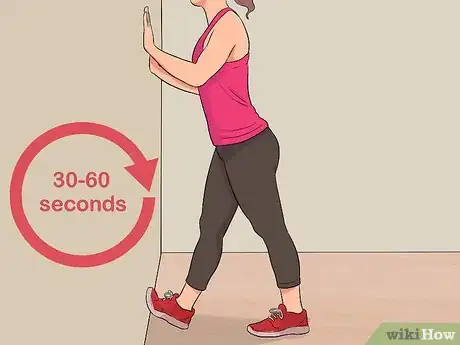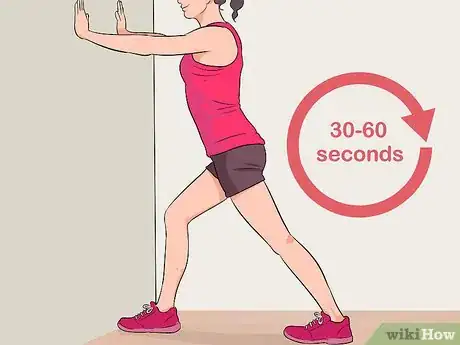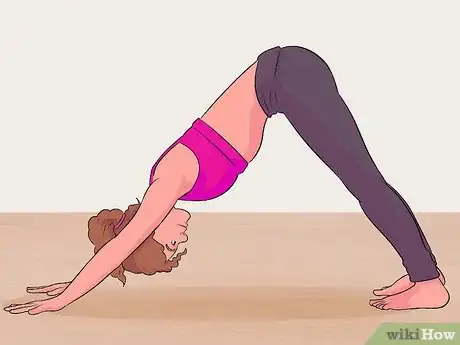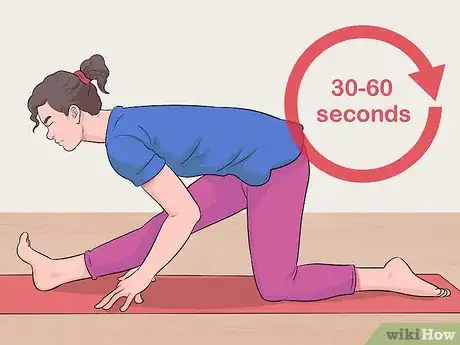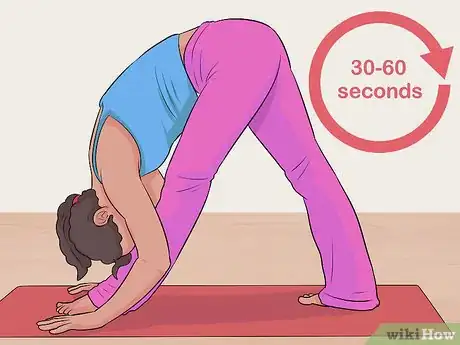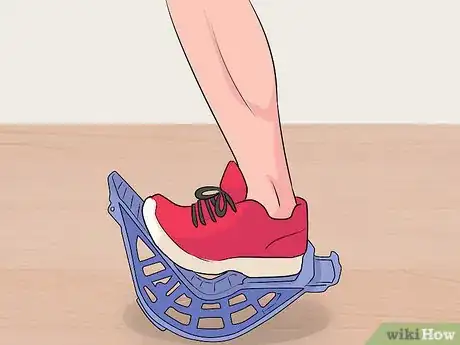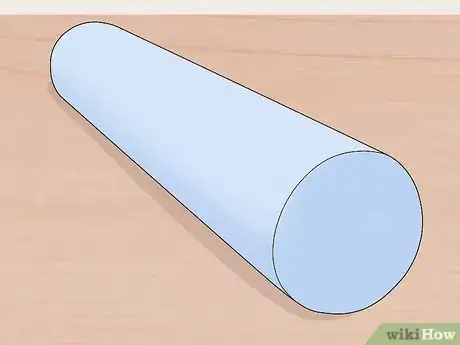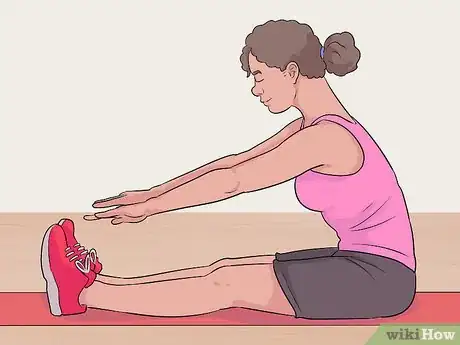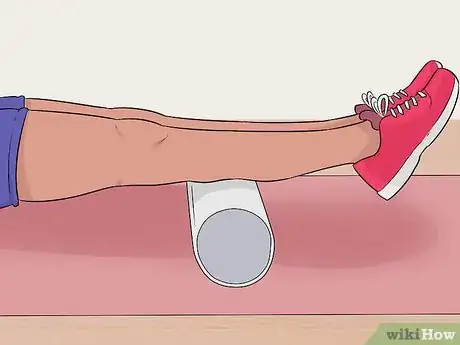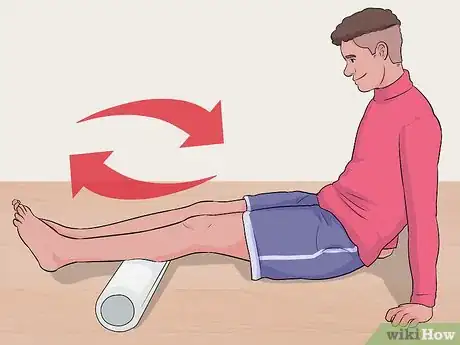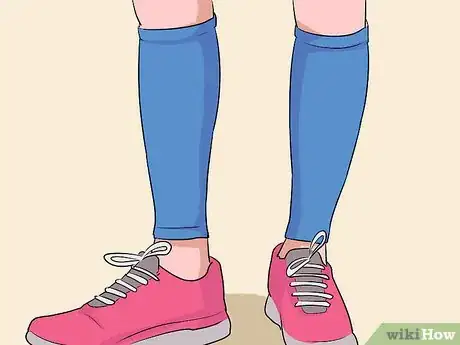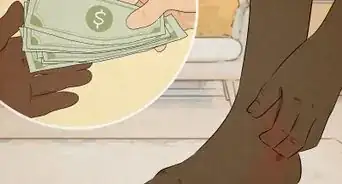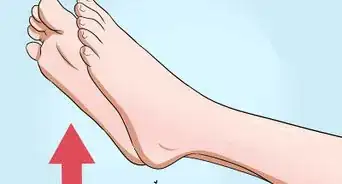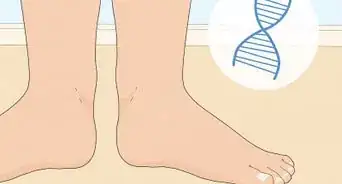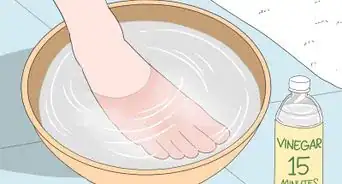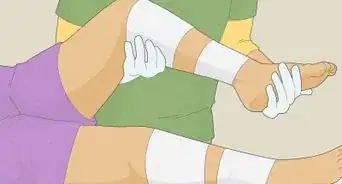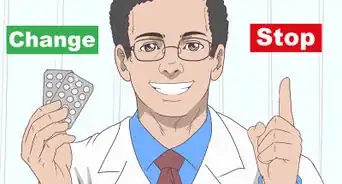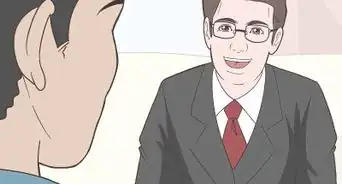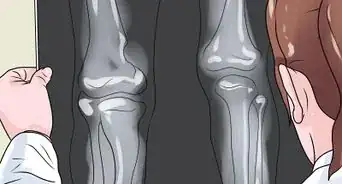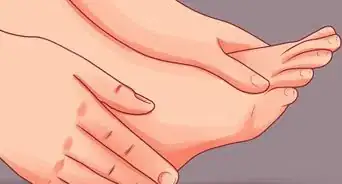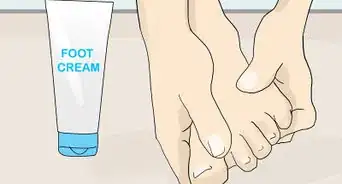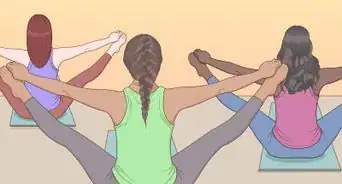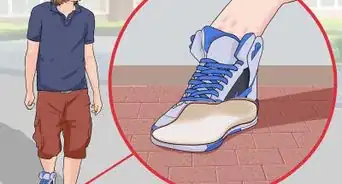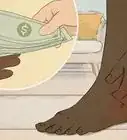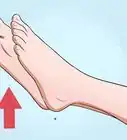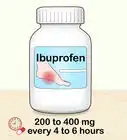This article was co-authored by Jason Whalen. Jason Whalen is a Certified Personal Trainer and the Owner of JWWFitness in Scottsdale, Arizona. With over a decade of experience, Jason specializes in strength, core, endurance, and plyometric training programs for those looking to improve their fitness, overall health, and sports performance. He holds a BA in Exercise Science from Eastern New Mexico University. Jason is also a Nutrition Therapist and a Member of the National Strength and Conditioning Association (NSCA). He was voted the Best of 2012 for Personal Trainers by Kudzu and was featured in Echo Magazine.
There are 8 references cited in this article, which can be found at the bottom of the page.
This article has been viewed 16,181 times.
Tight calves can be a painful experience and make it difficult for you to walk or run. You may develop stiff calf muscles due to playing sports or not stretching properly before a workout. Luckily, you can relieve tightness in this area by doing calf stretches and rolling out your calf muscles with a foam roller. You can also get a massage and other deep tissue treatments to address this uncomfortable issue.
Steps
Doing Calf Stretches
-
1Warm up before you stretch. Never stretch cold muscles, as this can lead to further injury in your calf muscles and other parts of your body. Go for a 5 minute walk or jog to lubricate your joints and warm up your muscles.
- You can also do jumping jacks, burpees, or sprints to warm up.
-
2Perform a standing calf stretch with your leg against a wall. Position yourself about 2 feet (0.61 m) away from a wall. Put the ball of your foot against the wall, keeping your heel on the ground.[1] Keep your other foot a few inches behind your front foot, flat on the ground. Lean into the wall, keeping your knee straight, but not locked. You should feel a stretch from your heel to your calf.[2]
- Hold the stretch for 30-60 seconds. Repeat it on the other side with your other foot against the wall.
Advertisement -
3Do a standing calf stretch with your hands against a wall. Stand about 3 feet (0.91 m) away from the wall and place your right foot behind your left foot, about 1 foot (0.30 m) apart. Keep your toes facing forward and your heels flat on the ground. Lean forward and bend your left knee slightly, pressing your hands against the wall. You should feel a stretch in your calf muscle on your right leg.[3]
- Hold the stretch for 30-60 seconds. Then, switch your legs so your right leg is forward and your left leg is behind you.
-
4Perform downward dog to stretch out your calves. Position yourself on all fours with your hands directly under your shoulders and your knees under your hips. Move your hands forward and spread your fingers apart. Lift your hips up towards the ceiling, keeping your knees slightly bent. Try straightening one leg and raising your heel up while the heel on the other leg touches the ground. Then, do this with the other leg so you can stretch both calf muscles.[4]
- Hold downward dog for several minutes, bending and straightening each leg. Try to eventually get both heels touching the ground to stretch your calf muscles.
-
5Do the half splits to release tightness in your calf muscles. Start by kneeling with your hips positioned over your knees. Stretch your right leg out in front of you, keeping your foot flexed and your heel resting on the ground. Place your hands on your hips and inhale as you fold your torso over your leg. Put your fingertips on the ground on either side of your leg. Make sure you bend your right knee slightly to protect it as you stretch your calf muscle.[5]
- Place yoga blocks on either side of your legs to ease into the stretch.
- Hold this position for 30-60 seconds. Then, rise and place your other leg out in front of you so you can stretch it.
-
6Try pyramid pose to stretch your calves. From a standing position, place your right foot forward and your left foot behind you, about 1 foot (0.30 m) apart. Point your right toes straight forward and your left toes slightly outward. Bend forward on your hips so your torso lays over your right leg. Place your hands on your shins or on the ground on either side of your leg. You can also prop your hands up on blocks on either side of your leg if your calves are very tight.[6]
- Hold this position for 30-60 seconds. Allow your upper body to fold over your leg as deep as you can go to get a good stretch.
- Switch to the other side, with your left foot in front and your right foot behind.
-
7Use a calf stretcher to release tension in your muscles. A calf stretcher is a specialized piece of equipment that can help you go deeper in your stretches and better support your calf muscles in stretches. Calf stretchers come in a variety of designs, from a horizontal bar that moves up and down on your foot to a curved stretcher with a flat top for your foot. Look for calf stretchers at your local fitness store or online.[7]
- You may need to try out a few calf stretchers to find the one that is right for you. Integrate the stretcher into your stretch routine to help release tension in your calf muscles.
Using a Foam Roller
-
1Buy a long foam roller at your local sporting goods store or online. Foam rollers are a great way to release tense muscles. Look for a foam roller that is thick and long so you can position it under your legs comfortably. Some foam rollers also come with a textured or bumpy surface to help you get a deep massage.[8]
- Foam rollers can range in price from $40-$100 USD, depending on the model.
-
2Sit down with your legs straight out in front of you. Flex your toes and bend your knees slightly.[9]
-
3Place the foam roller under your calf muscles. Slide the foam roller underneath your calf muscles, perpendicular to your body. Your calves should sit comfortable on top of the roller.[10]
-
4Roll your calf muscles back and forth on the roller to release them. Place your hands behind you and raise your hips so your weight is on your hands and calves. Gently push the roller up and down under your calf muscles to help release them.[11]
- Continue to roll out your calf muscles for 5-10 minutes. Try rolling very slowly to get deeper into your muscles.
-
5Use the foam roller once a day for 10-15 minutes at a time. Rolling out your calf muscles with the foam roller can really help to loosen up this area and prevent them from tightening up in the future. Get in the habit of rolling out your calf muscles after a workout or strenuous activity.[12]
Getting a Massage and Other Treatments
-
1Get a deep tissue massage done on your calves by a trained masseuse. A deep tissue massage can help to release tension in your calf muscles using targeted pressure on this area. The masseuse will focus on removing tightness in your calves to increase blood flow and elasticity in your muscles. Look for a masseuse trained in deep tissue release at your local massage parlor or studio.[13]
- Regular deep tissue massages once a month or several times a year can help to keep your calves from tightening up or being too stiff.
-
2Try acupuncture on your calves. Acupuncture is another great treatment for tight calves, as it helps to release the fascia around your muscles and loosen them up. Always get a treatment done by a trained acupuncturist who has experience working on tight calf muscles. Look for an acupuncturist at your local alternative medicine studio or center.[14]
- Going to see an acupuncturist regularly for treatment on your calves can help to prevent tightness in the future.
-
3Wear compression socks over your calves to reduce swelling and tension. Compression socks help to increase blood flow to your muscles, which can help to reduce tension and prevent them from tightening up in the future. Put compression socks on so they reach past your calves and wear them when you are sleeping or during the day. You can also try running or jogging while wearing compression socks so your calves do not become tight.[15]
- Look for compression socks at your local sporting goods store or online.
- Compression socks are also a good preventative measure you can take. As soon as your calves start to feel sore, put on the socks so they do not become too tight.
Expert Q&A
Did you know you can get expert answers for this article?
Unlock expert answers by supporting wikiHow
-
QuestionHow can I get smaller calf muscles?
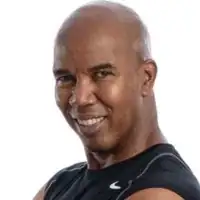 Danny GordonDanny Gordon is an American College of Sports Medicine (ACSM) Certified Personal Trainer and Owner of The Body Studio for Fitness, a fitness studio based in the San Francisco Bay Area. With over 20 years of physical training and teaching experience, he has focused his studio on semi-private personal training. Danny received his Personal Trainer Certification from the California State University, East Bay and the American College of Sports Medicine (ACSM).
Danny GordonDanny Gordon is an American College of Sports Medicine (ACSM) Certified Personal Trainer and Owner of The Body Studio for Fitness, a fitness studio based in the San Francisco Bay Area. With over 20 years of physical training and teaching experience, he has focused his studio on semi-private personal training. Danny received his Personal Trainer Certification from the California State University, East Bay and the American College of Sports Medicine (ACSM).
Certified Personal Trainer It depends on why they're big. If you were just born with naturally big calves, there isn't really anything you can do about it. If not, then you want to look at how many calories you're consuming to see how you can start losing weight. Getting exercise and building leaner calf muscles will help in this regard.
It depends on why they're big. If you were just born with naturally big calves, there isn't really anything you can do about it. If not, then you want to look at how many calories you're consuming to see how you can start losing weight. Getting exercise and building leaner calf muscles will help in this regard. -
QuestionWhy do I always feel pressure on my calf muscles?
 Danny GordonDanny Gordon is an American College of Sports Medicine (ACSM) Certified Personal Trainer and Owner of The Body Studio for Fitness, a fitness studio based in the San Francisco Bay Area. With over 20 years of physical training and teaching experience, he has focused his studio on semi-private personal training. Danny received his Personal Trainer Certification from the California State University, East Bay and the American College of Sports Medicine (ACSM).
Danny GordonDanny Gordon is an American College of Sports Medicine (ACSM) Certified Personal Trainer and Owner of The Body Studio for Fitness, a fitness studio based in the San Francisco Bay Area. With over 20 years of physical training and teaching experience, he has focused his studio on semi-private personal training. Danny received his Personal Trainer Certification from the California State University, East Bay and the American College of Sports Medicine (ACSM).
Certified Personal Trainer
-
QuestionWhat's the best way to stretch my calves?
 Jason WhalenJason Whalen is a Certified Personal Trainer and the Owner of JWWFitness in Scottsdale, Arizona. With over a decade of experience, Jason specializes in strength, core, endurance, and plyometric training programs for those looking to improve their fitness, overall health, and sports performance. He holds a BA in Exercise Science from Eastern New Mexico University. Jason is also a Nutrition Therapist and a Member of the National Strength and Conditioning Association (NSCA). He was voted the Best of 2012 for Personal Trainers by Kudzu and was featured in Echo Magazine.
Jason WhalenJason Whalen is a Certified Personal Trainer and the Owner of JWWFitness in Scottsdale, Arizona. With over a decade of experience, Jason specializes in strength, core, endurance, and plyometric training programs for those looking to improve their fitness, overall health, and sports performance. He holds a BA in Exercise Science from Eastern New Mexico University. Jason is also a Nutrition Therapist and a Member of the National Strength and Conditioning Association (NSCA). He was voted the Best of 2012 for Personal Trainers by Kudzu and was featured in Echo Magazine.
Certified Personal Trainer
References
- ↑ Jason Whalen. Certified Personal Trainer. Expert Interview. 26 January 2021.
- ↑ http://www.stretching-exercises-guide.com/calf-stretches.html
- ↑ http://www.stretching-exercises-guide.com/calf-stretches.html
- ↑ http://www.stretching-exercises-guide.com/calf-stretches.html
- ↑ https://yogainternational.com/article/view/yoga-for-tight-calves
- ↑ https://yogainternational.com/article/view/yoga-for-tight-calves
- ↑ https://www.fitday.com/fitness-articles/fitness/equipment/what-is-a-calf-stretcher.html
- ↑ https://www.prevention.com/fitness/3-ways-to-relieve-tight-leg-muscles-with-a-foam-roller
- ↑ https://www.prevention.com/fitness/3-ways-to-relieve-tight-leg-muscles-with-a-foam-roller
- ↑ http://www.stretching-exercises-guide.com/calf-stretches.html
- ↑ https://www.prevention.com/fitness/3-ways-to-relieve-tight-leg-muscles-with-a-foam-roller
- ↑ https://www.prevention.com/fitness/3-ways-to-relieve-tight-leg-muscles-with-a-foam-roller
- ↑ http://www.physio.co.uk/treatments/massage/benefits-of-massage/relieve-tight-muscles.php
- ↑ https://my.clevelandclinic.org/health/articles/acupuncture
- ↑ https://well.blogs.nytimes.com/2016/07/29/do-compression-sleeves-help-with-muscle-recovery/
